Toddler
A toddler is a child approximately 12 to 36 months old, though definitions vary.[1][2][3] The toddler years are a time of great cognitive, emotional and social development. The word is derived from "to toddle", which means to walk unsteadily, like a child of this age.[4]
| Part of a series on |
| Human growth and development |
|---|
 |
| Stages |
| Biological milestones |
| Development and psychology |
|
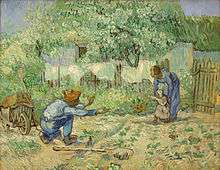
Developmental milestones

| Blood Pressure (mmHg) | Systolic | 80–110[5] |
| Diastolic | 50–80[5] | |
| Heart rate (BPM) | 90–140[5] | |
| Respiratory rate | 20–40[5] | |
Toddler development can be broken down into a number of interrelated areas.[6] There is reasonable consensus about what these areas may include:
- Physical: growth or an increase in size.
- Gross motor: the control of large muscles which enable walking, running, jumping and climbing.
- Fine motor: the ability to control small muscles; enabling the toddler to feed themselves, draw and manipulate objects.
- Vision: the ability to see near and far and interpret what is seen.
- Hearing and speech: the ability to hear and receive information and listen (interpret), and the ability to understand and learn language and use it to communicate effectively.
- Social: the ability to interact with the world through playing with others, taking turns and fantasy play.
Although it is useful to chart defined periods of development, it is also necessary to recognize that development exists on a continuum, with considerable individual differences between children. There is a wide range of what may be considered 'normal' development. However, according to experts, there are specific milestones that should be achieved by certain ages and stages in life in order to properly grow and develop.[7]
One year old

At one year of age, the typical toddler will be able to display the following skills:[8]
Physical and motor skills
- Triple the birth weight
- Grow to a height of 50% over birth length
- Have a head circumference equal to that of the chest
- Have one to eight teeth
- Pull to stand
- Walk with help or alone
- Sit down without help
- Bang two blocks together
- Turn through the pages of a book by flipping many pages at a time
- Have a pincer grasp
- Sleep 8–10 hours a night and take one to two naps
Sensory and cognitive development
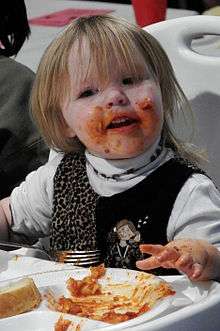
- Follows a fast moving object
- Can respond to sounds
- Responds to his or her name
- Understands several words
- Can say mama, papa, and at least one or two other words
- Understands simple commands
- Tries to imitate animal sounds
- Connects names with objects
- Understands that objects continue to exist, even when they are not seen (object permanence)
- Points to objects with index finger
- Waves bye bye
- May develop attachment to a toy or object
- Experiences separation anxiety and may cling to parents
- May make brief journeys away from parents to explore in familiar settings
Two years old
- Weight: about 11–13 kg
- Height: about 80–82 cm
- Teeth: 12 temporary
Two and half years old

- Teeth: full set of 20 temporary
- Decreased need for naps
.jpg)
Motor development
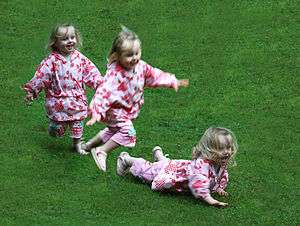
14 months
.jpg)
- Walks well alone with wide based gait
- Creeps upstairs
- Builds with blocks
- Drinks from a cup, uses spoon
- Enjoys throwing objects and picking them up
18 months
- Walks sideways and backwards, runs well, falls easily
- Climbs stairs or up on furniture
- Scribbles vigorously, attempting a straight line
- Drinks well from a cup, still spills with a spoon
Two years
- Gross motor skills are quite well refined, can walk up and down stairs on both feet with one step at a time while holding on to a rail
- Builds tower of five cubes
- Control of spoon well-developed
- Toilet trained during day time
Vocalization and socialization
15 months
- Can use 10-15 words
- Says "no" (see holophrasis)
- Indicates when diaper is wet
18 months
- Uses phrases composed of adjectives and nouns
- Begins to have temper tantrums
- Very ritualistic, has favorite toy or blanket
- Thumb sucking may be at peak
Two years
- Vocabulary of about 350 words
- Obeys simple commands
- Helps undress self and put on simple clothes
- Shows sign of increased autonomy and individuality
- Does not share possessions—everything "mine" as in the "Toddler's Creed":[9]
"If I want it, it's mine.
If I give it to you and change my mind later, it's mine.
If I can take it away from you, it's mine.
If I had it a little while ago, it's mine.
If it's mine it will never belong to anyone else, no matter what.
If we are building something together, all the pieces are mine.
If it looks like mine, it's mine."
—Burton L. White in his Raising a Happy, Unspoiled Child<ref name="Burton L. White 1995"/>
2½ years
- Begins to see self as separate individual; still sees other children as "objects"
Major learning events
Toilet training
- Readiness: The Azrin and Foxx method of toilet training introduced the first set of objective criteria for determining whether a child is prepared to begin toilet training. The child should be physiologically and psychologically capable. Physiologic preparedness describes the ability of the child to perform tasks necessary for toilet training such as controlling their anal and urethral sphincter, sitting upright, and walking. Physiologic readiness describes the child's motivation to become toilet trained and their ability to understand and follow directions.[10]
- Process training
- Parental response
Play (parallel play)
- Child plays alongside other children but not with them
- Mostly free and spontaneous, no rules or regulations
- Attention span very short and change of toys occurs at frequent intervals
- Imitation and make-believe play begins by end of the second year
Games: throwing and retrieving objects
Suggested toys:
- Play furniture, dishes, cooking utensils, play telephone, puzzles with large pieces, pedal propelled toys, rocking horse, clay crayons, finger paints, pounding toys, blocks, push-pull toys, balls
Squatting
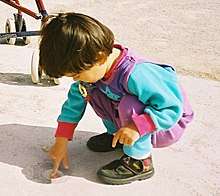
Young children squat instinctively as a continuous movement from standing up whenever they want to lower themselves to ground level. One- and two-year-olds can commonly be seen playing in a stable squatting position, with feet wide apart and bottom not quite touching the floor, although at first they need to hold on to something to stand up again.[11]
Language
Talking is the next milestone of which parents are typically aware. A toddler's first word often occurs around 12 months, but again this is only an average.[12] The child will then continue to steadily add to his or her vocabulary until around the age of 18 months when language increases rapidly. He or she may learn as many as 7–9 new words a day. Around this time, toddlers generally know about 50 words. At 21 months is when toddlers begin to incorporate two word phrases into their vocabulary, such as "I go", "mama give", and "baby play". Before going to sleep they often engage in a monologue called crib talk in which they practice conversational skills. At this age, children are becoming very proficient at conveying their wants and needs to their parents in a verbal fashion.
Emotions and self-image
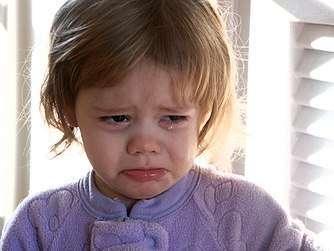
.jpg)
There are several other important milestones that are achieved in this time period that parents tend not to emphasize as much as walking and talking. Gaining the ability to point at whatever it is the child wants you to see shows huge psychological gains in a toddler. This generally happens before a child's first birthday.
This age is sometimes referred to as "the terrible twos",[13] because of the temper tantrums for which they are famous. This stage can begin as early as nine months old depending on the child and environment. Toddlers tend to have temper tantrums because they have such strong emotions but do not know how to express themselves the way that older children and adults do.[14] They also throw tantrums to let others know that they are free and can do what they want. The toddler is discovering that they are a separate being from their parent and are testing their boundaries in learning the way the world around them works. Although the toddler is in their exploratory phase, it is also important to understand that the methods used by the parents for communicating with the toddler can either set off a tantrum or calm the situation.[15][16] Research has shown that parents with histories of maltreatment, violence exposure, and related psychopathology may have particular difficulty in responding sensitively and in a developmentally appropriate manner to their toddlers' tantrums and thus may benefit from parent-child mental health consultation.[17][18] This time between the ages of two and five when they are reaching for independence repeats itself during adolescence.
Self-awareness is another milestone that helps parents understand how a toddler is reacting. Around 18 months of age, a child will begin to recognize himself or herself as a separate physical being with his/her own thoughts and actions. A parent can test if this milestone has been reached by noticing if the toddler recognizes that their reflection in a mirror is in fact themselves. One way to test this is the rouge test: putting lipstick on the child's face and showing them their own reflection. Upon seeing the out-of-the-ordinary mark, if the child reaches to his or her own face, the child has achieved this important milestone. Along with self recognition comes feelings of embarrassment and pride that the child had not previously experienced.
Overview
The toddler developmental timeline shows what an average toddler can do at what age from 12 months onward. Times vary greatly from child to child. It is common for some toddlers to master certain skills such as walking well before other skills, like talking. Even close siblings can vary greatly in the time taken to achieve each key milestone.[19]
| Age | Physical | Mental | Emotional |
|---|---|---|---|
| 12–14 months |
|
|
|
| 15–18 months |
|
|
|
| 19–24 months |
|
|
|
| 25–36 months |
|
|
|
See also
- Child development stages
- Early childhood
- Early childhood education
- Sign language in infants and toddlers
References
- "toddler". The Free Dictionary.
- Barker, Robin (2001) The Mighty Toddler: The essential guide to the toddler years, Pan Macmillan Australia, Sydney, p1.
- Lieberman, Alicia F, (1993) The Emotional Life of the Toddler, The Free Press, New York, p1.
- Brown, Stephanie (December 19, 2015). "What Is the Definition of a Toddler?". verywell.com, an About.com site. About, Inc. Retrieved November 13, 2016.
The term toddler comes from the way that children first walk, which is at first unsteady and more like a toddle than actual walking.
- PEDIATRIC AGE SPECIFIC, page 6. Revised 6/10. By Theresa Kirkpatrick and Kateri Tobias. UCLA Health System
- Barker, Robin (2001) The Mighty Toddler: The essential guide to the toddler years, Pan Macmillan Australia, Sydney, p19.
- Toddler growth, Gold Learners
- Feigelman S. The first year. In: Kliegman RM, Behrman RE, Jenson HB, Stanton BF, eds. Nelson Textbook of Pediatrics. 18th ed. Philadelphia, Pa: Saunders Elsevier; 2007: chapter 8 quoted in Developmental milestones record - 12 months MedlinePlus Medical Encyclopedia
- Burton L. White, Raising a Happy, Unspoiled Child (Simon and Schuster [Fireside Book], 1995), 161.
- Klassen, Terry P; Kiddoo, Darcie; Lang, Mia E; Friesen, Carol; Russell, Kelly; Spooner, Carol; Vandermeer, Ben (December 2006). "The effectiveness of different methods of toilet training for bowel and bladder control". Evidence Report/Technology Assessment (147): 1–57. ISSN 1530-4396. PMC 4781561. PMID 17764212.
- Slentz K, Krogh S Early Childhood Development and Its Variations (2001)
- "Child talking timeline". babycentre.
- "The Terrible Twos Explained - Safe Kids (UK)". Safe Kids. Retrieved 2010-12-08.
- Kuersten-Hogan, Regina; McHale, James P. (1998). "Talking About Emotions During the Toddler Years and Beyond: Mothers' and Fathers' Coaching of Children's Emotion Understanding". Infant Behavior and Development. 21: 514. doi:10.1016/s0163-6383(98)91727-1. ISSN 0163-6383.
- Fields-Olivieri, Margaret A.; Cole, Pamela M.; Maggi, Mirella C. (2017). "Toddler Emotional States, Temperamental Traits, and their Interaction: Associations with Mothers' and Fathers' Parenting". Journal of Research in Personality. 67: 106–119. doi:10.1016/j.jrp.2016.05.007. ISSN 0092-6566. PMC 5415346. PMID 28479643.
- "Toddlers World". Archived from the original on 2011-02-07.
- Gudmundson, Jessica A.; Leerkes, Esther M. (2011). "Links Between Mothers' Coping Styles, Toddler Reactivity, and Sensitivity to Toddler's Negative Emotions". Infant Behavior and Development. 35 (1): 158–166. doi:10.1016/j.infbeh.2011.07.004. ISSN 0163-6383. PMC 3245338. PMID 21903276.
- Schechter DS, Moser D, Wang Z, Marsh R, Hao XJ, Duan Y, Yu S, Gunter B, Murphy D, McCaw J, Kangarlu A, Willheim E, Myers M, Hofer M, Peterson BS (2012). "An fMRI Study of the Brain Responses of Traumatized Mothers to Viewing their Toddlers During Separation and Play". Journal of Social, Cognitive and Affective Neuroscience. 7 (8): 969–79. doi:10.1093/scan/nsr069. PMC 3501701. PMID 22021653.
- "Toddler Developmental Timeline". Gold Learners. Gold Learners.